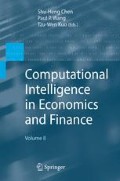Abstract
This paper outlines a data mining approach to the analysis and prediction of the trend of stock prices. The approach consists of three steps, namely, partitioning, analysis and prediction. A commonly used k-means clustering algorithm is used to partition stock price time series data. After data partition, linear regression is used to analyse the trend within each cluster. The results of the linear regression are then used for trend prediction for windowed time series data. Using our trend prediction methodology, we propose a trading strategy TTP (Trading based on Trend Prediction). Some results of applying TTP to stock trading are reported. The trading performance is compared with some practical trading strategies and other machine learning methods. Given the volatility nature of stock prices the methodology achieved limited success for a few countries and time periods. Further analysis of the results may lead to further improvement in the methodology. Although the proposed approach is designed for stock trading, it can be applied to the trend analysis of any time series, such as the time series of economic indicators.
Access this chapter
Tax calculation will be finalised at checkout
Purchases are for personal use only
Preview
Unable to display preview. Download preview PDF.
References
Agrawala R, Faloutsos C, Swami A (1993) Efficient similarity search in sequence databases. In: Proceedings of the 4th international conference on foundations of data organization and algorithms:13–15
Chambers JM, Hastie TJ (eds) (1992) Statistical models in s. Chapman & Hall/CRC
Chen SH, He H (2003) Searching financial patterns with self-organizing maps. In: Chen SH, Wang PP (eds) Computational intelligence in economics and finance. Springer-Verlag:203–216
Chen SH, Kuo TW, Hsu KM (2007) Genetic programming and financial trading: how much about “what we know”? In: Zopounidis C, Doumpos M, Pardalos PM (eds) Handbook of financial engineering. Springer. Forthcoming.
Ge X (1998) Pattern matching financial time series data. Project Report ICS 278, UC Irvine
Han J, Kamber M (2001) Data mining: concepts and techniques. Morgan Kaufmann Publishers, San Francisco, CA, USA
Jin HD, Leung KS, Wong ML, Xu ZB (2005) Scalable model-based cluster analysis using clustering features. Pattern Recognition 38(5):637–649
Jin H, Wong ML, Leung KS (2005) Scalable model-based clustering for large databases based on data summarization. IEEE Transactions on Pattern Analysis and Machine Intelligence 27(11):1710–1719
Keogh E, Smyth P (1997) A probabilistic approach to fast pattern matching in time series databases. In: Proceedings of KDD’97:24–30
MacQueen JB (1967) Some methods for classification and analysis of multivariate observations. In: Proceedings of 5-th Berkeley symposium on mathematical statistics and probability. Berkeley, University of California:281–297
Patel P, Keogh E, Lin J, Lonardi S (2002) Mining motifs in massive time series databases. In: Proceedings of the 2002 IEEE international conference on data mining:370–377
Author information
Authors and Affiliations
Editor information
Editors and Affiliations
Rights and permissions
Copyright information
© 2007 Springer-Verlag Berlin Heidelberg
About this chapter
Cite this chapter
He, H., Chen, J., Jin, H., Chen, SH. (2007). Trading Strategies Based on K-means Clustering and Regression Models. In: Chen, SH., Wang, P.P., Kuo, TW. (eds) Computational Intelligence in Economics and Finance. Springer, Berlin, Heidelberg. https://doi.org/10.1007/978-3-540-72821-4_7
Download citation
DOI: https://doi.org/10.1007/978-3-540-72821-4_7
Publisher Name: Springer, Berlin, Heidelberg
Print ISBN: 978-3-540-72820-7
Online ISBN: 978-3-540-72821-4
eBook Packages: Computer ScienceComputer Science (R0)

